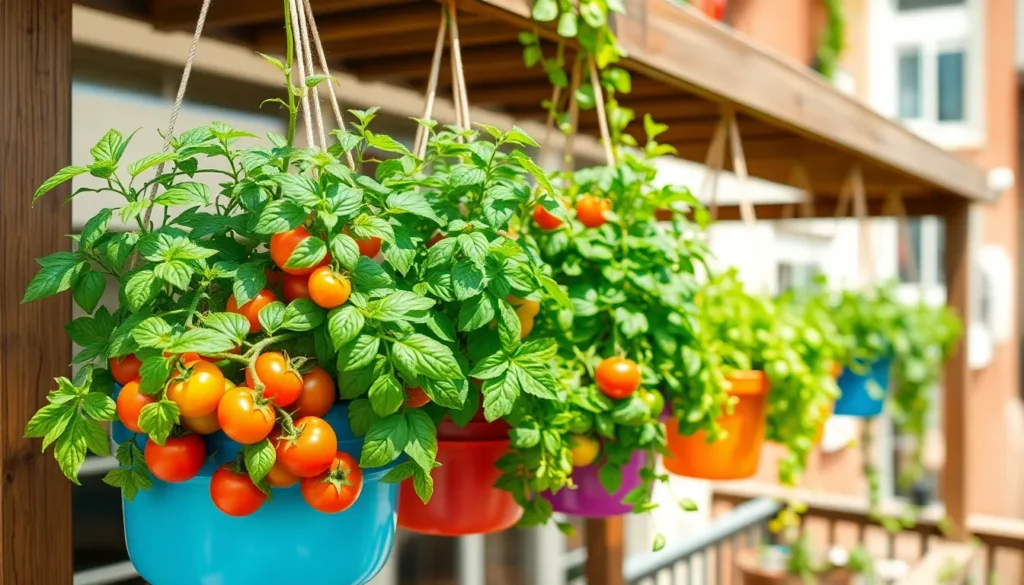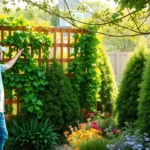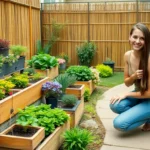Limited garden space doesn’t mean you can’t grow fresh vegetables at home. We’ve discovered that hanging vegetable gardens offer an incredible solution for maximizing your growing potential while adding visual appeal to any space. Whether you’re working with a tiny balcony apartment or want to make better use of your patio these elevated growing systems transform vertical areas into productive food sources.
Hanging gardens aren’t just practical – they’re surprisingly easy to maintain and harvest. We’ll show you how suspended planters reduce pest problems eliminate weeding and make watering more efficient than traditional ground-level gardens. Plus your vegetables stay cleaner and more accessible when they’re hanging at eye level.
From cherry tomatoes cascading down in colorful clusters to herbs swaying gently in the breeze hanging vegetable gardens create stunning displays that neighbors will envy. We’ve tested dozens of techniques and container combinations to bring you the most effective ideas that actually work for real gardeners with busy schedules.
Hanging Tomato Gardens for Maximum Yield
Maximizing tomato production in hanging containers requires strategic variety selection and proper support systems to handle the weight of mature plants loaded with fruit.
Cherry Tomato Varieties That Thrive in Hanging Baskets
Tumbling Tom varieties produce cascading stems that naturally spill over basket edges while generating impressive yields of sweet cherry tomatoes. We’ve observed these determinate plants reaching 6-8 inches in height while spreading 12-20 inches wide in 12-inch hanging baskets.
Sweet ‘n’ Neat varieties deliver compact growth patterns perfect for smaller hanging containers while producing abundant clusters of 1-inch cherry tomatoes. These plants typically yield 60-80 tomatoes per basket throughout the growing season.
Trailing varieties like Tumbler and Balcony create stunning visual displays with their naturally drooping growth habit while producing continuous harvests of flavorful cherry tomatoes. Both varieties mature in 65-70 days and perform exceptionally well in 14-16 inch hanging baskets.
Micro Tom cultivars offer the smallest footprint for hanging tomato gardens while still producing genuine tomatoes rather than ornamental fruits. These ultra-compact plants reach only 6-8 inches tall but generate 20-30 small tomatoes per plant in 8-10 inch containers.
Supporting Heavy Tomato Plants with Proper Basket Selection
Heavy duty baskets with reinforced chains become essential when growing indeterminate tomato varieties that can reach 15-20 pounds when fully loaded with fruit. We recommend baskets rated for at least 25-30 pounds to provide adequate safety margins.
Coco fiber lined baskets measuring 16-20 inches offer optimal root space for larger tomato varieties while providing excellent drainage and natural insulation. These baskets hold 3-4 gallons of growing medium, which supports healthy root development and consistent moisture levels.
Self watering hanging planters eliminate the daily watering challenges that plague traditional hanging tomato gardens while maintaining consistent soil moisture levels. These systems typically include water reservoirs holding 1-2 quarts and wicking mechanisms that draw moisture upward to plant roots.
Wire basket reinforcement with additional support cables becomes necessary for cherry tomato plants producing over 100 fruits per season. We install secondary support points using adjustable plant ties connected to overhead structures to distribute weight evenly across multiple attachment points.
Hanging Herb Gardens for Fresh Kitchen Access
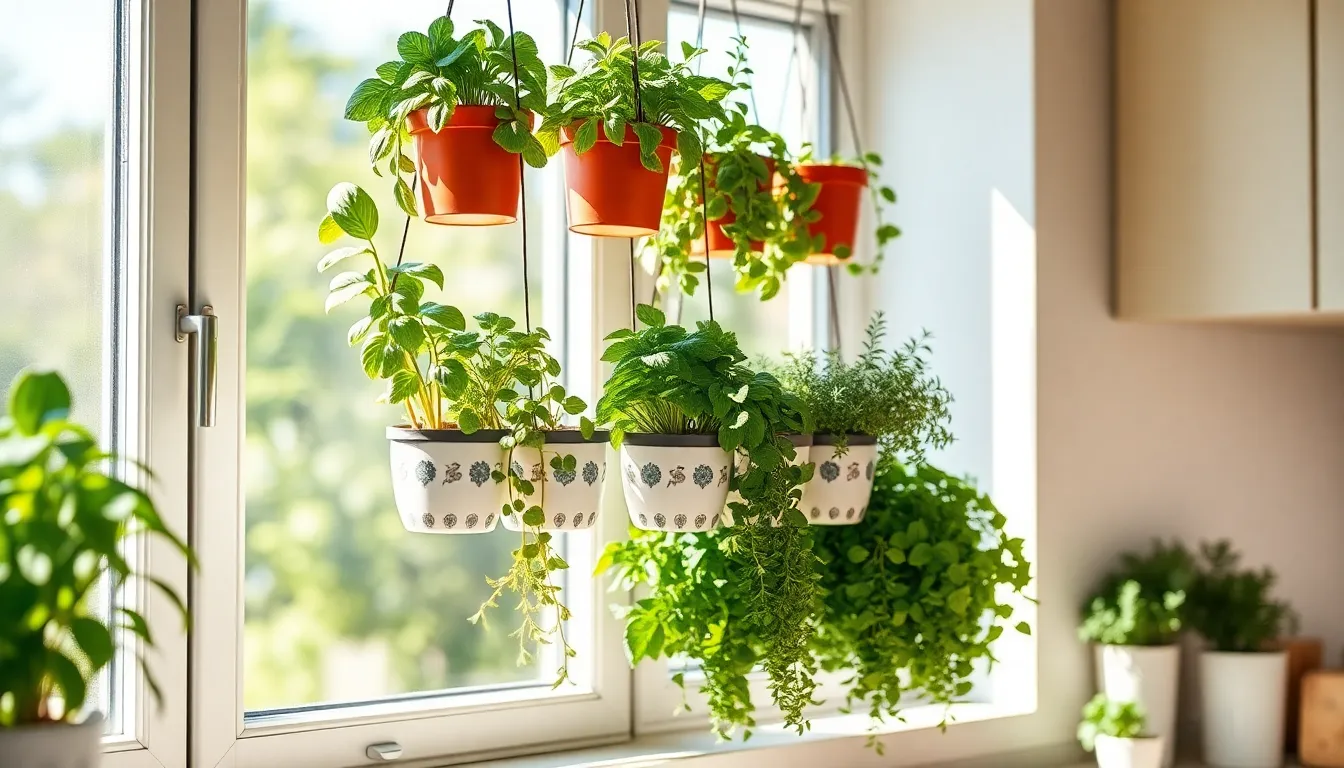
Hanging herb gardens bring culinary convenience right to your doorstep while maintaining the space-saving benefits we’ve established with vertical growing systems. We’ve found that positioning herb containers near kitchen windows or outdoor cooking areas creates the ultimate fresh ingredient access point.
Essential Culinary Herbs Perfect for Vertical Growing
Basil varieties thrive in hanging containers and provide endless opportunities for pesto creation and caprese salad enhancement. We recommend starting with sweet basil for beginners, as it adapts well to suspended growing conditions and produces abundant leaves throughout the growing season.
Mint establishes quickly in hanging baskets and delivers refreshing flavor for drinks, desserts, and Middle Eastern dishes. Container growing actually benefits mint by controlling its aggressive spreading nature that can overtake ground gardens.
Rosemary adapts beautifully to vertical growing and offers year-round harvesting potential in mild climates. We’ve discovered that hanging rosemary plants develop stronger root systems and better drainage, resulting in more concentrated essential oils and enhanced flavor profiles for roasted meats and vegetables.
Thyme produces prolifically in suspended planters and serves as a versatile addition to soups, stews, and garnish applications. Creeping thyme varieties create attractive cascading effects while providing continuous harvest opportunities.
Parsley grows vigorously in hanging systems and delivers fresh color and nutrition to countless dishes. Both flat-leaf and curly varieties perform well in vertical gardens, with flat-leaf parsley offering superior flavor intensity.
Companion Planting Strategies for Mixed Herb Containers
Basil and mint combinations create natural pest deterrents while offering complementary flavors for Mediterranean and Asian cuisine. We plant these together in larger hanging baskets, spacing them adequately to prevent mint from overwhelming the basil’s growth pattern.
Rosemary and thyme partnerships excel in shared containers because both herbs prefer similar drainage conditions and watering schedules. These Mediterranean natives complement each other in savory cooking applications while creating aromatic hanging displays.
Parsley and chives pairings add visual appeal through contrasting textures and provide fresh ingredients for everyday cooking needs. We position parsley toward container centers with chives cascading over edges, creating layered growing arrangements that maximize harvest potential.
Three herb combinations work effectively when we select varieties with similar water and light requirements, such as oregano, sage, and marjoram grouped together for Italian cooking themes.
Hanging Pepper Gardens for Spicy Harvests
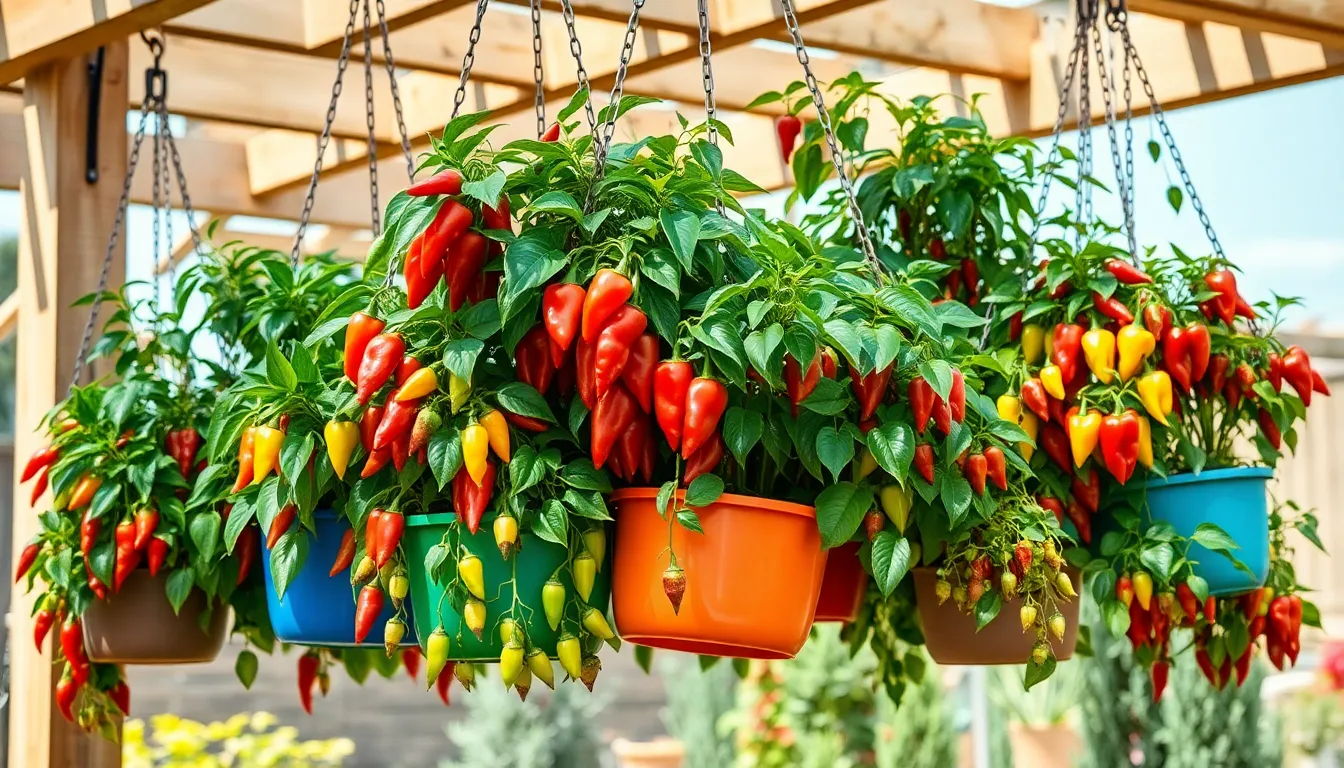
Peppers transform hanging gardens into productive spice stations that deliver concentrated flavor in compact spaces. We’ve discovered that suspended pepper cultivation offers exceptional yields while creating stunning visual displays throughout the growing season.
Compact Pepper Varieties Ideal for Suspended Growing
Thai Hot peppers excel in hanging baskets due to their naturally compact growth habit and lightweight fruit production. These fiery varieties produce abundant small peppers that won’t overwhelm your suspension system while delivering intense heat levels perfect for cooking enthusiasts.
Bird’s Eye peppers offer another excellent choice for aerial gardens with their upright growing pattern and manageable plant size. We’ve found these varieties adapt exceptionally well to container restrictions while producing impressive yields of tiny, potent peppers that pack serious culinary punch.
Patio pepper varieties specifically bred for container growing provide the perfect balance of size and productivity for hanging systems. These dwarf cultivars typically reach 12-18 inches in height and produce full-sized peppers without the weight concerns of traditional pepper plants.
Ornamental pepper varieties combine beautiful foliage with edible fruits, creating hanging displays that serve both aesthetic and culinary purposes. Popular varieties include Purple Flash and Chilly Chili, which produce colorful peppers while maintaining compact growth patterns ideal for suspended cultivation.
Managing Weight Distribution for Heavy Pepper Plants
Balanced planter positioning prevents tipping and ensures stable growth by distributing weight evenly across your hanging system. We recommend using planters with wide bases and positioning them so the center of gravity remains low throughout the growing season.
Reinforced hanging systems become essential when growing productive pepper varieties that develop heavy fruit loads. Sturdy chains or marine-grade rope provide the necessary support, while secure attachment points to pergolas or ceiling structures prevent system failure during peak production periods.
Lightweight potting mixes reduce overall container weight while maintaining proper drainage and nutrient retention for healthy pepper growth. Commercial potting blends specifically formulated for containers offer the ideal balance of weight reduction and growing medium quality.
Progressive harvesting techniques help maintain manageable weight levels by removing mature peppers before they become too heavy for the suspension system. Regular picking also encourages continued production and prevents branches from breaking under excessive fruit loads.
Hanging Lettuce and Leafy Green Systems

We’ve discovered that lettuce and leafy greens offer the perfect introduction to hanging vegetable gardens because of their shallow root systems and quick growth cycles. These systems work exceptionally well in hanging baskets or gutters mounted on walls and fences.
Cut-and-Come-Again Varieties for Continuous Harvests
Cut-and-come-again varieties give us the ability to harvest fresh greens continuously throughout the growing season. Lettuce, kale, spinach, and arugula regrow after cutting, making them ideal choices for sustained production. We recommend harvesting leaves from the outside of each plant while allowing the center to continue developing new growth.
Loose-leaf lettuce varieties thrive in our hanging systems because they don’t require deep soil like head lettuce. These varieties produce tender leaves that we can pick individually as needed for salads and cooking. Regular harvesting every few days encourages more leaf production and prevents the plants from bolting prematurely.
Strategic harvesting techniques maximize our yield from each hanging container. We cut leaves when they reach 3-4 inches in length, taking only what we need for immediate use. This approach keeps the plants productive for weeks longer than traditional harvesting methods.
Creating Tiered Hanging Systems for Multiple Greens
Tiered systems allow us to grow multiple varieties of leafy greens in compact vertical arrangements. Wooden pallets, crates, and repurposed containers work well for creating these multi-level displays. We can mount these systems at different heights to accommodate various plant sizes and growth patterns.
Material selection impacts both functionality and visual appeal in our tiered gardens. Lightweight containers reduce strain on hanging hardware while providing adequate growing space for shallow-rooted greens. We arrange different types of greens in each tier to create attractive color combinations and ensure proper spacing.
Proper arrangement maximizes both space efficiency and aesthetic value in our hanging systems. We place taller varieties like kale on upper tiers and trailing varieties like certain lettuce types on lower levels. This configuration allows each plant adequate light exposure while creating an appealing cascading effect that enhances any garden space.
Hanging Bean and Pea Climbing Gardens
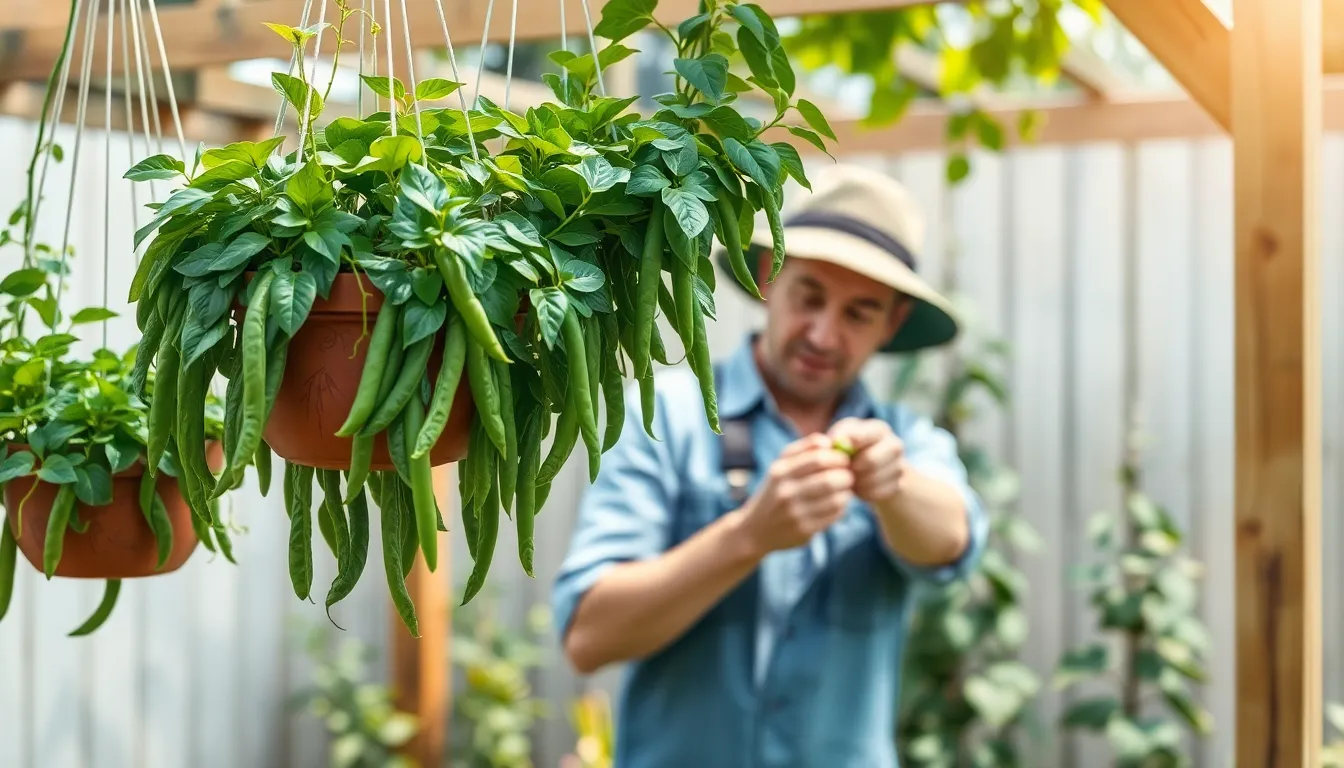
Beans and peas transform hanging baskets into productive vertical gardens that maximize growing space while creating living green walls. These climbing vegetables naturally use tendrils and stems to ascend support structures, making them perfect candidates for suspended growing systems.
Training Vines to Grow Downward in Hanging Planters
Training climbing vegetables to cascade downward requires selecting the right trailing varieties and proper planting techniques. We plant beans and peas at the top of tall containers, allowing their vines to spill over the edges and create dramatic hanging displays. Cherry tomatoes, cucumbers, and exact bean cultivars respond well to this downward training method when we guide young vines over the planter edge as they develop.
Soil depth becomes crucial for successful downward training since roots need adequate space to support cascading growth. We use lightweight, moisture-retentive soil mixes that prevent containers from becoming too heavy while maintaining consistent hydration levels. Regular guidance of young shoots ensures vines follow the desired downward path instead of searching for upward support structures.
Watering frequency increases with hanging planters since they dry out faster than ground-based gardens. We monitor moisture levels daily and adjust our watering schedule based on weather conditions and plant maturity. Positioning these cascading gardens near sunny walls or fences provides optimal light exposure while protecting plants from strong winds.
Support Structures for Climbing Vegetable Varieties
Sturdy support systems ensure climbing vegetables like beans, peas, cucumbers, and tomatoes reach their full productive potential in hanging gardens. We attach trellises, cages, stakes, and netting directly to hanging containers or mount them on nearby walls and structures. Vertical strings and mesh work particularly well for gutter gardens suspended from fences or pergolas.
Repurposed materials offer cost-effective and customizable support answers for vertical growing systems. We incorporate reclaimed wood, metal scraps, and wire mesh to create durable frameworks that withstand the weight of mature climbing plants. These recycled materials often provide better longevity than standard garden center options when properly treated and installed.
Container attachment methods vary depending on the support structure and vegetable variety we’re growing. Beans and peas require lighter support systems since their tendrils naturally grip thin materials, while heavier vegetables like cucumbers need robust frameworks. We secure support structures before planting to avoid disturbing established root systems later in the growing season.
Indoor applications extend the growing season for climbing vegetables in hanging systems throughout the year. We position containers near bright windows or supplement with grow lights to maintain adequate photosynthesis levels. Temperature control and air circulation become important factors for successful indoor climbing vegetable production.
Hanging Strawberry Tower Gardens
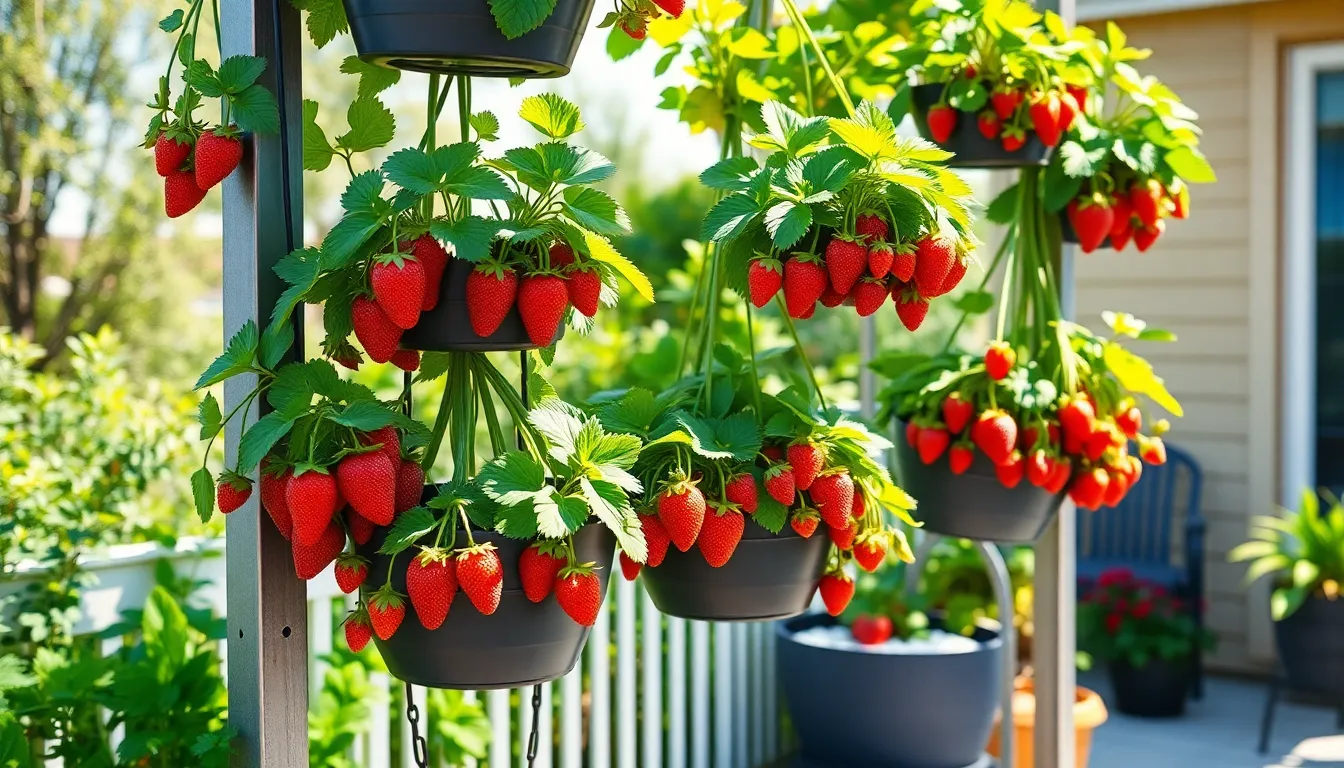
Strawberry tower gardens transform vertical space into productive berry stations that rival traditional ground level plantings. We’ve discovered these stacked systems deliver exceptional yields while adding stunning visual appeal to patios, balconies, and garden corners.
Stacking Multiple Baskets for Vertical Berry Production
Creating strawberry towers involves positioning multiple hanging baskets or planters at different heights to maximize growing space. We recommend using a series of baskets suspended from a sturdy frame or mounting system that distributes weight evenly across the structure.
Starting with larger containers at the bottom provides stability for the entire tower system. The upper baskets should be progressively smaller to ensure each level receives adequate sunlight exposure. This stepped approach prevents upper containers from shading lower ones completely.
Adapting this vertical method works perfectly for other berry producing plants like cherry tomatoes or small pepper varieties. We’ve successfully grown multiple strawberry varieties in single towers by dedicating each level to different cultivars with varying harvest times.
Positioning baskets 18 to 24 inches apart vertically creates optimal spacing for maintenance access. The systematic arrangement allows water to cascade naturally from upper levels while maintaining proper drainage throughout the tower.
Proper Spacing and Care for Hanging Strawberry Plants
Spacing strawberry plants 6 to 8 inches apart in hanging containers prevents overcrowding and promotes healthy air circulation. We’ve found that cramped plants develop fungal issues and produce smaller berries due to competition for nutrients and sunlight.
Watering hanging strawberry gardens requires daily attention during warm weather since suspended containers dry out faster than ground level plantings. The exposed surfaces of hanging baskets lose moisture through evaporation more rapidly than traditional garden beds.
Fertilizing strawberry towers every 2 to 3 weeks with balanced liquid fertilizer maintains consistent production throughout the growing season. We use a 10-10-10 fertilizer diluted to half strength to prevent root burn while providing essential nutrients.
Ensuring each level receives 6 to 8 hours of direct sunlight daily maximizes berry production and sweetness. Strategic positioning of towers allows morning sun to reach lower levels while preventing afternoon shade from blocking upper containers.
Regular inspection for runners helps maintain plant vigor since strawberry plants naturally produce offshoots that can overcrowd containers. We trim excess runners to focus plant energy on berry production rather than vegetative growth.
Hanging Root Vegetable Container Ideas
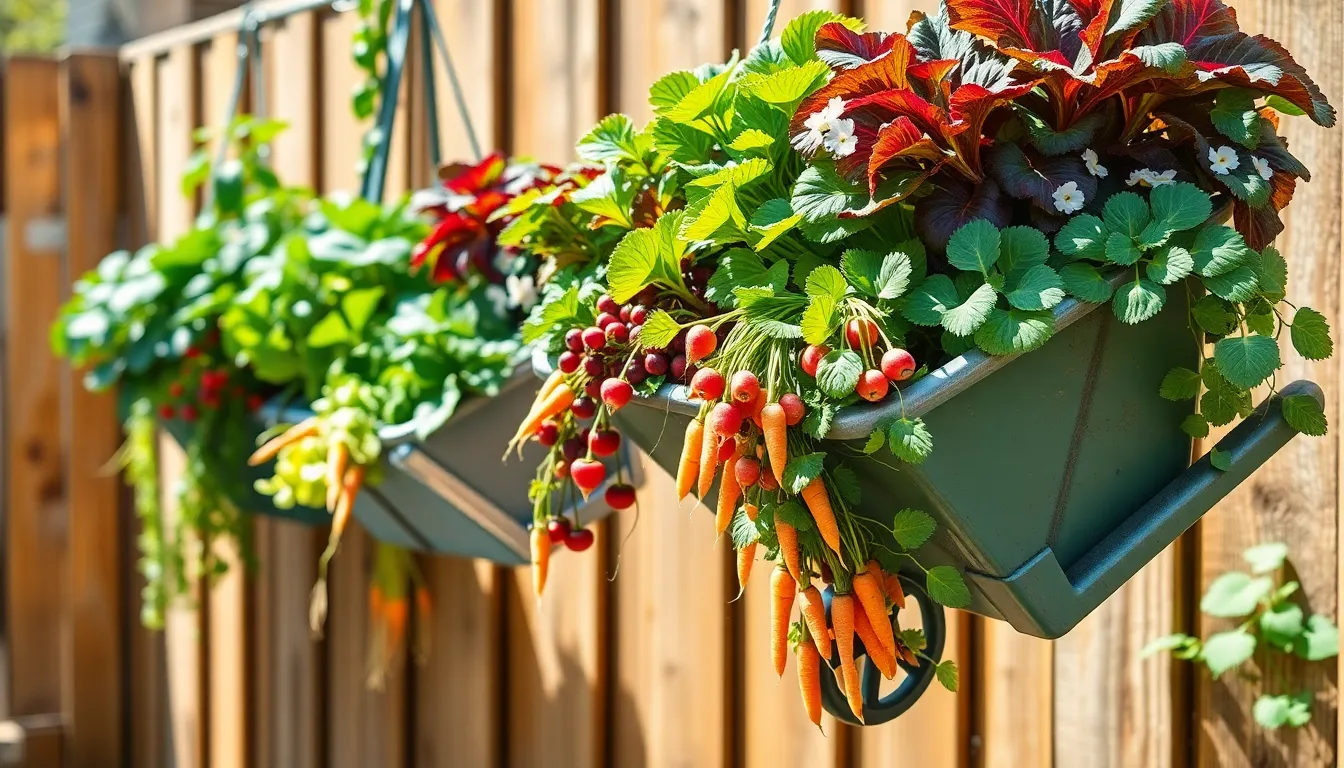
Growing root vegetables in hanging containers requires strategic planning since most root crops need substantial depth. We’ve discovered that shallow-rooted varieties and creative container answers make vertical root vegetable gardening achievable and productive.
Shallow-Root Vegetables Perfect for Hanging Gardens
Radishes thrive in hanging gardens due to their quick growth cycle and shallow root requirements. These fast-growing vegetables mature in just 3-4 weeks and need only 4-6 inches of soil depth. We recommend growing Cherry Belle radishes and French Breakfast varieties in hanging baskets for optimal results.
Lettuce varieties excel in suspended growing systems because of their fibrous root structure and compact growth habit. Buttercrunch lettuce, Red Sails, and Black Seeded Simpson all perform exceptionally well in hanging containers with 6-8 inches of soil depth. These leafy greens provide continuous harvests when grown using cut-and-come-again methods.
Baby carrots adapt well to hanging planters when you select short varieties like Paris Market or Thumbelina carrots. These compact cultivars reach maturity at 1-2 inches long and require only 6-8 inches of growing depth. We’ve found that round carrot varieties produce better yields than traditional long varieties in hanging systems.
Green onions flourish in vertical growing environments since they need minimal root space and tolerate crowded conditions. Evergreen Hardy White and Parade scallions grow continuously in hanging containers with just 4 inches of soil. These versatile vegetables provide fresh harvests for months with proper care and regular watering.
Creative Container Answers for Root Crop Growing
Window boxes maximize shallow root vegetable production by providing extended growing space along horizontal surfaces. We mount these containers on railings, walls, or windowsills to create dedicated root crop growing areas. Standard window boxes offer 6-8 inches of depth, perfect for radishes, baby carrots, and green onions.
Repurposed wheelbarrows create mobile root vegetable gardens that combine deep growing space with portability benefits. Old wheelbarrows provide 12-18 inches of soil depth when properly prepared with drainage holes in the bottom. We fill these containers with lightweight potting mix to maintain manageable weight while supporting deeper root vegetables like small potatoes and turnips.
Hanging gutter systems deliver efficient space utilization for multiple shallow root crops in compact areas. We mount gutters horizontally along fences or suspend them from pergolas to create productive growing channels. These systems work exceptionally well for radish succession planting and baby lettuce production throughout the growing season.
Stacked bucket planters offer tiered root vegetable growing by creating vertical tower systems with varied soil depths. We drill drainage holes in food-grade buckets and connect them with sturdy chains or cables. This approach allows us to grow different root vegetables at various levels based on their exact depth requirements.
Hanging Garden Installation and Setup Tips
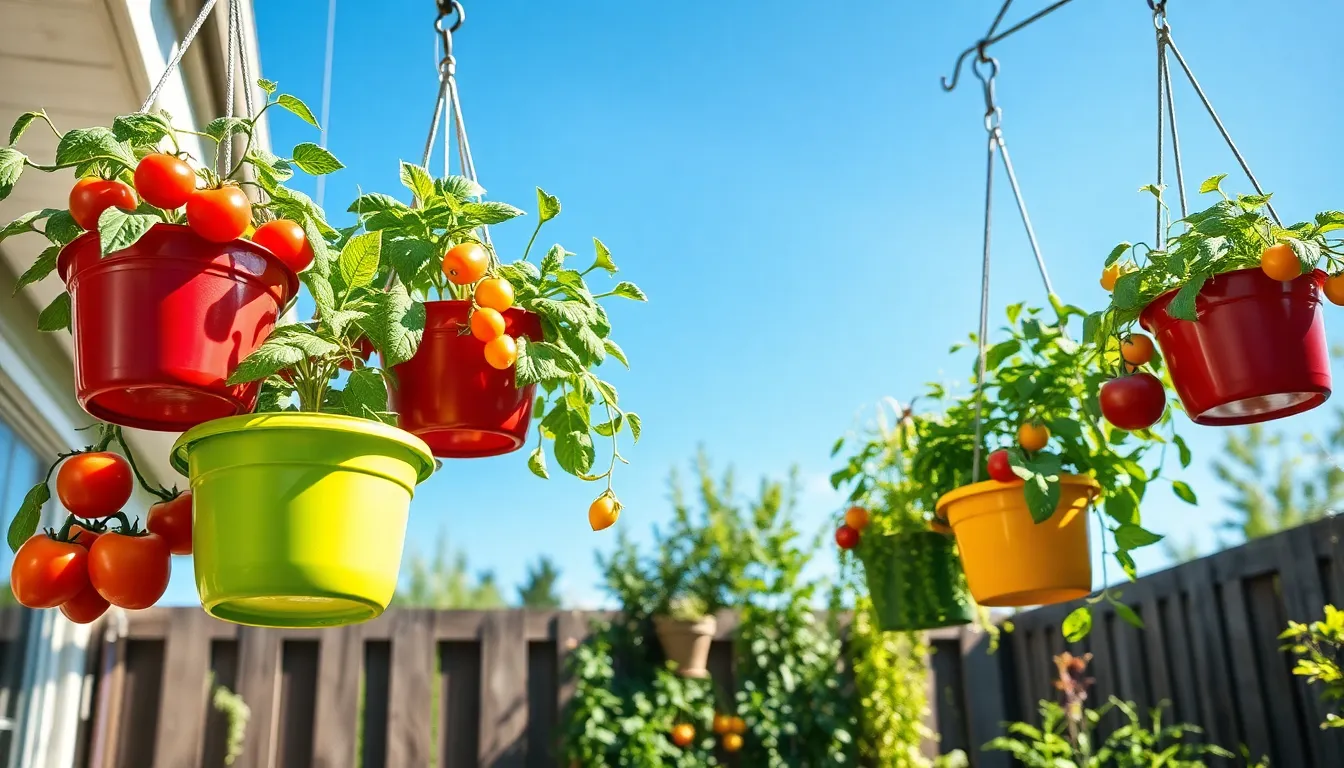
We’ll guide you through the essential steps to create a successful hanging vegetable garden that thrives throughout the growing season. Proper installation and setup form the foundation for productive vertical gardening.
Choosing the Right Location for Optimal Sun Exposure
Sunlight Requirements determine the success of your hanging vegetable garden. Most vegetables require at least 6 hours of direct sunlight per day to produce healthy harvests.
Avoiding Shading becomes crucial when positioning your hanging containers. We recommend surveying your space throughout the day to identify areas that receive consistent sunlight without interference from buildings, trees, or other structures.
Morning Sun provides the most beneficial light exposure for vegetable growth. East-facing locations capture the gentle morning rays while protecting plants from intense afternoon heat.
Wind Protection helps prevent your hanging gardens from excessive swaying and moisture loss. Position containers near walls or fences that offer some shelter while maintaining adequate air circulation.
Accessibility matters when selecting your hanging garden location. Choose spots where you can easily reach your plants for daily maintenance, watering, and harvesting without straining or using ladders.
Weight Considerations and Proper Hanging Hardware
Calculate Weight before installing any hanging system by considering the combined weight of soil, plants, water, and containers. A fully saturated hanging basket can weigh 20-40 pounds depending on size and contents.
Use Lightweight Containers made from plastic, fabric, or fiberglass to reduce overall weight stress on your hanging system. These materials offer durability while keeping the total load manageable for most standard mounting hardware.
Sturdy Hooks and Chains provide the backbone of successful hanging gardens. We recommend using galvanized steel hooks rated for at least twice the expected weight of your fully loaded containers.
Mounting Points require careful evaluation of the structure’s load-bearing capacity. Attach hanging hardware to solid wood beams, concrete, or metal framework rather than drywall or thin materials.
Drainage Considerations prevent waterlogged soil and root rot while managing weight distribution. Drill multiple drainage holes in container bottoms and use well-draining potting mix to maintain optimal moisture levels without excess weight.
Progressive Weight Management involves starting with lighter loads and gradually increasing as plants establish. Begin with smaller containers or fewer plants per basket, then expand your hanging garden as your support system proves reliable.
Watering and Maintenance for Hanging Vegetable Gardens
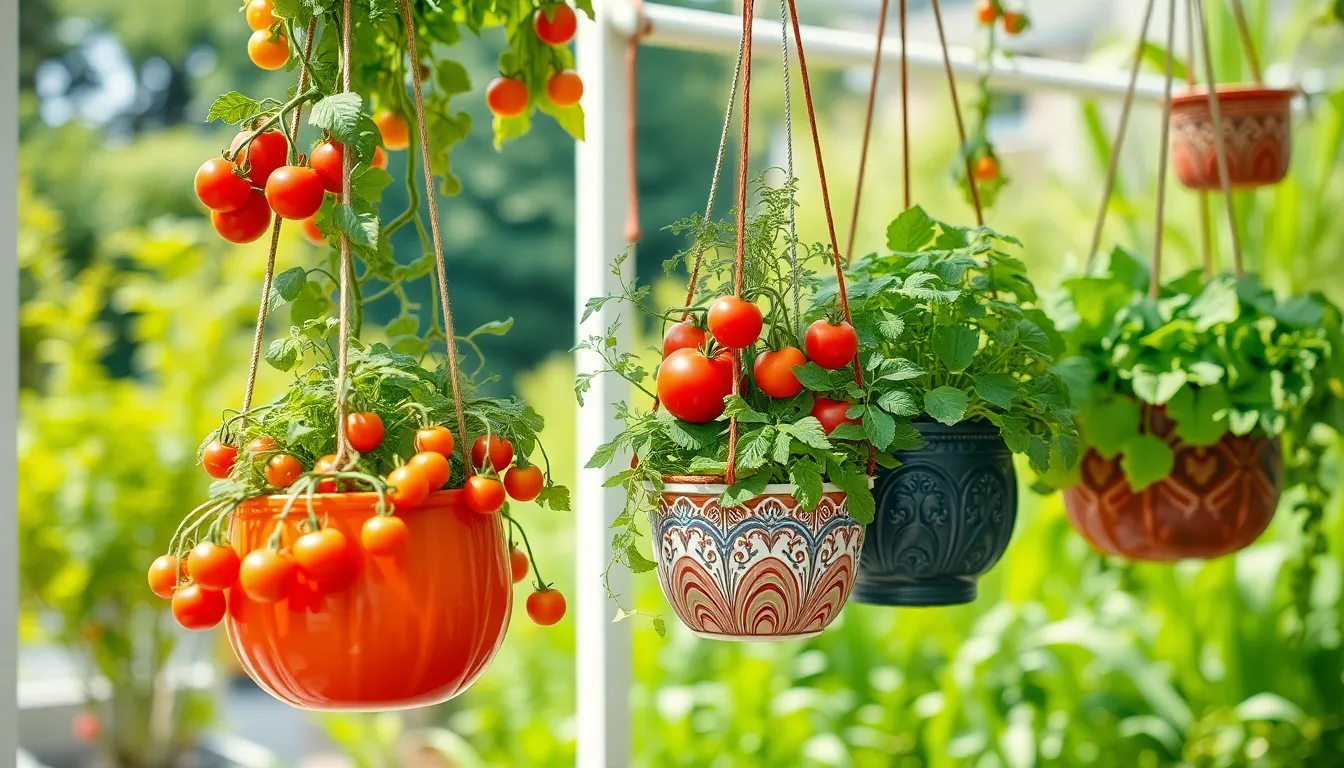
Proper watering and maintenance strategies ensure your hanging vegetable gardens thrive while minimizing effort and maximizing harvest potential.
Drip Irrigation Systems for Suspended Planters
Drip irrigation systems are highly effective for suspended planters because they deliver water directly to plant roots while reducing evaporation and runoff. We recommend installing these automated systems to maintain consistent moisture levels without the daily hassle of hand watering.
Timer controlled drip systems eliminate guesswork by providing scheduled watering intervals throughout the day. Smart controllers adjust watering frequency based on weather conditions and seasonal needs.
Individual emitter lines allow us to customize water delivery for different vegetable types within the same hanging garden setup. Cherry tomatoes require more frequent watering than herbs, making targeted irrigation essential for mixed plantings.
Pressure compensating drippers ensure equal water distribution across all hanging containers regardless of their height differences. Multiple tiers receive consistent moisture levels without over or under watering exact plants.
Self cleaning emitters prevent clogging from mineral deposits and organic matter that commonly accumulate in suspended growing systems. Regular maintenance involves monthly flushing to maintain optimal water flow rates.
Preventing Soil Erosion and Nutrient Loss
Mulch layers provide the most effective barrier against soil erosion in hanging containers by creating a protective surface that holds growing medium in place during watering and wind exposure. We apply 2 inch layers of organic mulch around plant bases.
Moss coverings serve as natural soil stabilizers that prevent nutrient rich potting mix from washing through drainage holes during heavy watering sessions. Sphagnum moss works particularly well for retaining moisture while allowing proper air circulation.
Coconut fiber liners create structural barriers within hanging baskets that contain soil while permitting adequate drainage for healthy root development. These biodegradable liners break down slowly over the growing season.
Regular soil condition checks help us identify when nutrient levels drop below optimal ranges for vegetable production. We test pH levels monthly and adjust fertilizer applications based on plant growth patterns and leaf color changes.
Slow release fertilizers maintain steady nutrient availability throughout the growing season without requiring frequent liquid feeding applications. Granular fertilizers mixed into potting soil provide 3 to 4 months of balanced nutrition for most hanging vegetable varieties.
Compost tea applications replenish beneficial microorganisms and organic matter that leach from suspended containers more quickly than ground based gardens. Weekly compost tea feedings restore soil biology essential for nutrient uptake.
Space-Saving Hanging Garden Arrangements
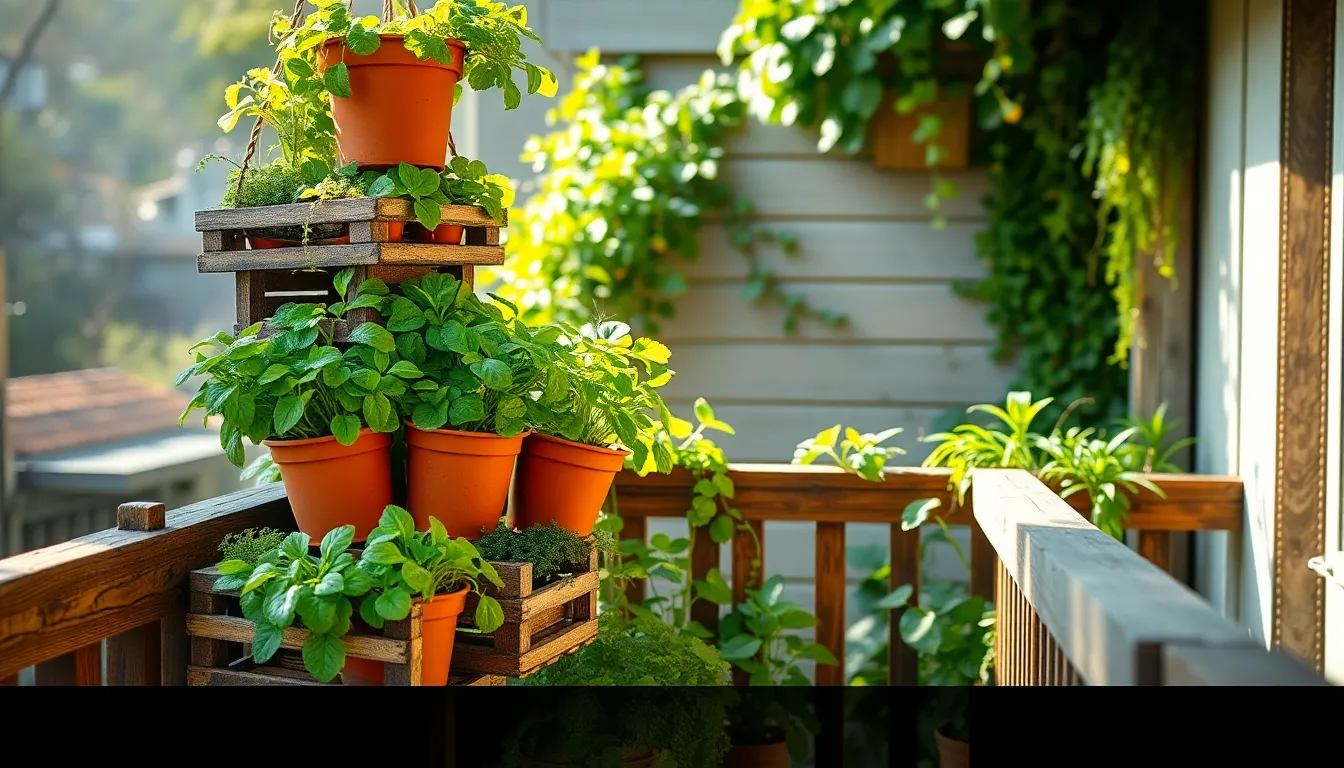
Building on our foundation of vertical gardening techniques, we’ll explore innovative arrangements that transform even the smallest outdoor areas into productive growing spaces.
Maximizing Small Balcony and Patio Spaces
Tiered vegetable towers create multiple growing levels within a single footprint. Stack pots or crates vertically to maximize your space while adding visual appeal that transforms ordinary balconies into lush garden retreats. We’ve found that three-tier arrangements work best for most patio spaces without overwhelming the area.
Repurposed container gardens offer cost-effective answers for budget-conscious gardeners. Old wheelbarrows and large tubs become productive planters when you drill drainage holes and fill them with nutrient-rich soil. These containers accommodate various vegetables while maintaining mobility for seasonal adjustments.
DIY trellis systems incorporate arch structures that support climbing plants while saving precious floor space. Mount these vertical supports against walls or railings to create living green screens. Bean and pea varieties thrive in this configuration, cascading downward to create stunning edible displays.
Corner hanging arrangements use often-overlooked spaces where walls meet. Position L-shaped bracket systems in these areas to support multiple containers at varying heights. This approach maximizes growing potential without interfering with foot traffic or furniture placement.
Multi-Level Hanging Systems for Urban Gardening
Vertical straw bale gardens stack bales vertically and secure them with chicken wire or wooden stakes. This method provides excellent drainage while remaining cost-effective for urban gardeners with limited budgets. Each bale accommodates different vegetable varieties, creating diverse growing zones within a compact vertical structure.
Ladder herb gardens transform old stepladders into productive growing towers. Each rung supports individual containers filled with herbs or compact vegetables. We position these structures against sunny walls where they receive optimal light exposure throughout the day.
Customized gutter systems mount along walls or fences using cut-to-size sections with drainage holes. These narrow planters excel for shallow-rooted vegetables like lettuce, spinach, and herbs. Install multiple levels at 18-inch intervals to create cascading green walls that maximize vertical growing space.
Pulley-operated hanging systems allow height adjustment for different plant varieties and growth stages. Attach containers to rope and pulley mechanisms that raise or lower planters as needed. This flexibility accommodates both sun-loving and shade-tolerant vegetables within the same vertical arrangement.
Modular hanging towers use stackable components that expand upward as your garden grows. Begin with single containers and add levels throughout the season. Each module operates independently while contributing to an impressive vertical garden display that adapts to changing needs.
Conclusion
We’ve shown how hanging vegetable gardens transform even the tiniest spaces into productive growing areas. These vertical systems deliver fresh vegetables while creating stunning displays that enhance any outdoor area.
The versatility of suspended gardens means you can grow everything from cherry tomatoes to leafy greens regardless of your space limitations. With proper installation and maintenance techniques we’ve covered you’ll enjoy easier harvesting and reduced pest problems.
Your hanging garden success depends on choosing the right varieties and implementing effective watering systems. We’re confident these space-saving answers will revolutionize how you think about urban gardening and maximize your growing potential.
Frequently Asked Questions
What are the main benefits of hanging vegetable gardens?
Hanging vegetable gardens maximize growing space in small areas while reducing pest issues and eliminating weeding. They provide easier maintenance, better accessibility for harvesting, and keep vegetables cleaner. These vertical systems also enhance visual appeal and offer improved watering efficiency through better drainage and reduced soil contact with ground-dwelling pests.
Which vegetables work best in hanging gardens?
Cherry tomatoes, herbs, compact peppers, and leafy greens are ideal for hanging gardens. Varieties like Tumbling Tom tomatoes, Thai Hot peppers, and cut-and-come-again lettuce thrive in suspended containers. These plants have manageable root systems, appropriate weight distribution, and continuous harvest potential that suits vertical growing conditions.
How do I choose the right location for my hanging garden?
Select spots with 6-8 hours of morning sunlight, protection from strong winds, and easy access for maintenance. Avoid areas that create shade for other plants. Consider proximity to water sources and ensure the location can support the weight of mature plants. Kitchen windows are ideal for herb gardens.
What type of containers and support systems should I use?
Use heavy-duty baskets with reinforced wire frames and self-watering planters for consistent moisture. Install sturdy hooks rated for plant weight plus soil and water. Consider lightweight potting mixes and progressive harvesting to manage weight. Pulley systems can help with maintenance access for higher installations.
How do I properly water and maintain hanging vegetable gardens?
Install drip irrigation systems with timers for consistent moisture without overwatering. Use mulch layers and coconut fiber liners to prevent soil erosion. Apply slow-release fertilizers and compost tea regularly. Check soil conditions frequently since hanging containers dry out faster than ground-level gardens.
Can I create tiered hanging systems for multiple vegetables?
Yes, tiered arrangements maximize space efficiency and allow growing multiple varieties simultaneously. Position taller plants higher to prevent shading shorter ones below. Use modular systems that can expand as your garden grows. Ensure each level receives adequate light and has proper spacing for air circulation.
What are the best pepper varieties for hanging gardens?
Compact varieties like Thai Hot, Bird’s Eye, and ornamental peppers work excellently in hanging systems. These varieties produce high yields while maintaining manageable plant size. Patio pepper varieties bred specifically for containers also thrive in suspended growing conditions and provide continuous harvests throughout the season.
How do I prevent my hanging garden from becoming too heavy?
Use lightweight potting mixes instead of garden soil, choose appropriately sized containers, and harvest progressively to reduce fruit load. Position planters strategically for balanced weight distribution. Consider the mature plant size when selecting varieties, and ensure your hanging hardware can support the full weight of established plants.

